If you go to Japan, you might as well watch sumo wrestling, which is Japan's indigenous wrestling style. Famous throughout the world, sumo is considered one of those "must-do" things during a visit to the country.
Sumo has a history stretching back to the 3rd century. Archaeologists have unearthed figurines of sumo wrestlers that come from the 3rd and 7th centuries. In addition, sumo can be found in Japanese history books from the 8th century called the Kojiki and Nihonshoki. When it was rice-plantin' time, sumo matches were held as a way to say, "Hey gods! How is the weather gonna be and also give us good crops, will ya?".
Sumo changed to its present for in the Edo period. Bouts were held as fundraisers for shrines, temples, and bridges. Though the sport was initially only for the wealthy, it is now enjoyed by the masses. And today, the masses means you and me! So, let's check it out, shall we?

JR Ryogoku Station is a famous station because of its proximity to Ryogoku Kokugikan sumo stadium. Fans of sumo wrestling flock here in droves. On the day of a match it gets quite crowded. Everyone is excited to see sumo titans do battle!
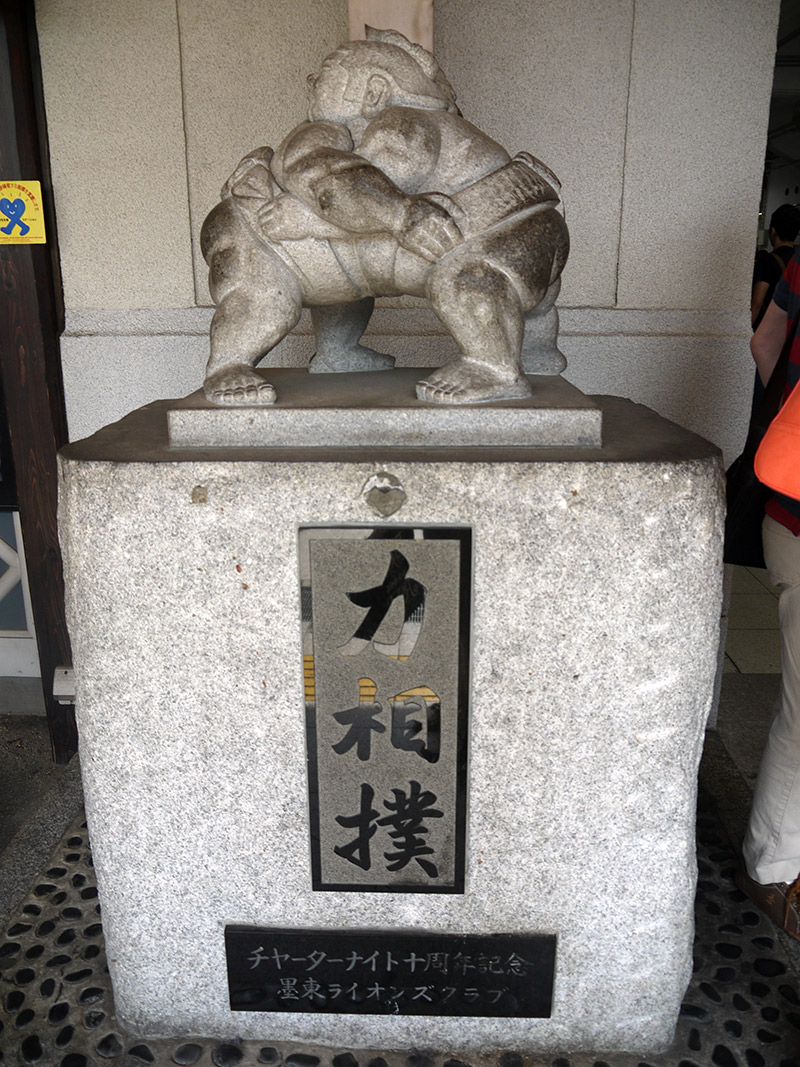
There was a cute sumo wrestler statue at the station. Their butts were a little black for some reason. Maybe spankings from passersby?

The stadium is located within walking distance from the station. You'll know you're getting close when you see the many colorful flags called nobori. If you don't read Japanese, make sure not to confuse them with nobori in front of convenience stores. You'll know you're in the wrong place if you see a snacks, drinks, magazines, and no sumo wrestlers.


One of the most exciting draws of visiting this area on the day of a match is the chance to see sumo wrestlers up close and personal. We saw these guys, but they didn't see us. Or at least they pretended not to. Sumo wrestlers must have a lot on their minds before a match.

If you see a sumo wrestler on the street, don't bother him or you might get a sumo whoopin'. This guy was actually slapped as a part of stunt for Japanese TV. But don't think that means a sumo wrestler won't slap you when the cameras aren't rolling.

This is the entrance to Ryogoku-Kokugikan. Beyond these gates lies a world of solemn tradition mixed with adenaline-fueled SMACKDOWNS! Yeeee-haw!
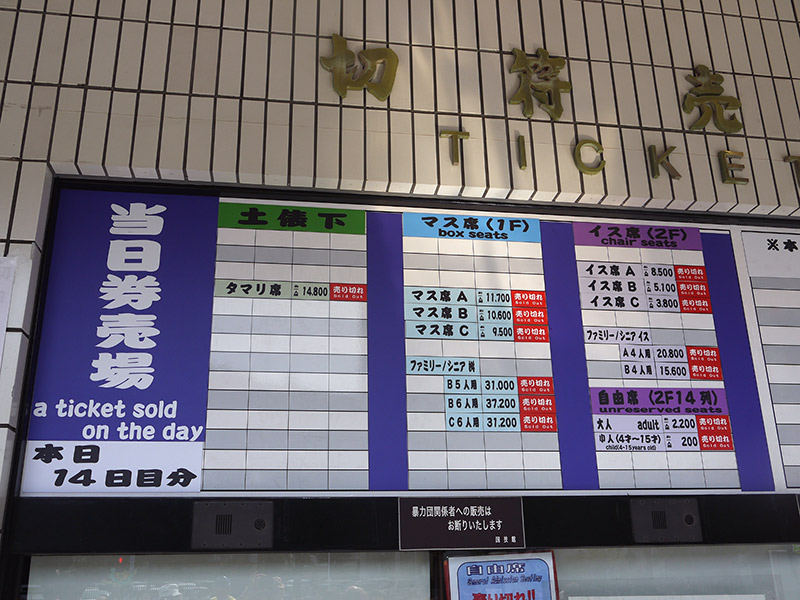
You can buy tickets if there are any left. They are often sold out, as they were on the day that I went (That's what all those red blocks mean). So I recommend buying tickets beforehand. If you have a ticket, feel free to taunt those who don't once you are beyond the gate. (Actually don't do that. That would make you a jackass.)

Once inside, there is a second entrance to actually enter the stadium. Make sure to pose in front of the giant sumo mural. The wrestlers in the mural are painted to scale. This is a great place to snap some pics, so have your camera ready!
Beyond this gate is where the magic happens. The lumbering, slappy magic.
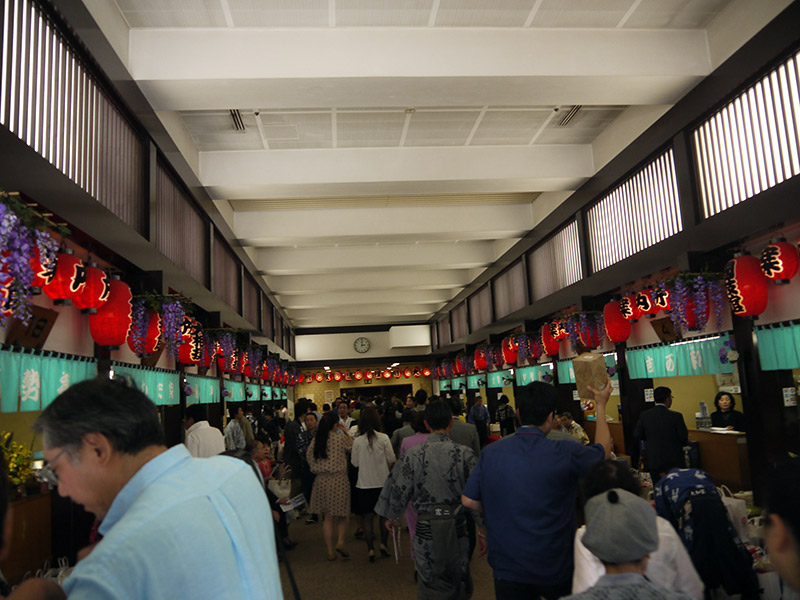
This place is called "Sumo Annaijo", which means "Sumo information bureau". These establishments escort you to your seat and provide souvenir and dining services.

In the annnaijo, You'll see many shops where you can receive your meals and souvenirs and get a guide to your seat, but you'll only get them if you have pre-ordered them. That lady is looking at us like, "Hey, don't take that pre-ordered stuff." She's one tough cookie. Like a Pecan Sandy made of hardtack.

I got a bag from the annaijo because my friends who took me here had pre-ordered it. (Thansk friend!) I was so happy to find this snack, called "Cheese Tara (Cod)," in my bag, which goes really well with beer. Yum!

You're finally in the stadium! It's time to watch sumo wrestlers go toe-to-toe, palm-to-palm, and mawashi-to-mawashi.

These matches were broadcast nationally. Thank you, cameraman. おつかれさまでーーす!
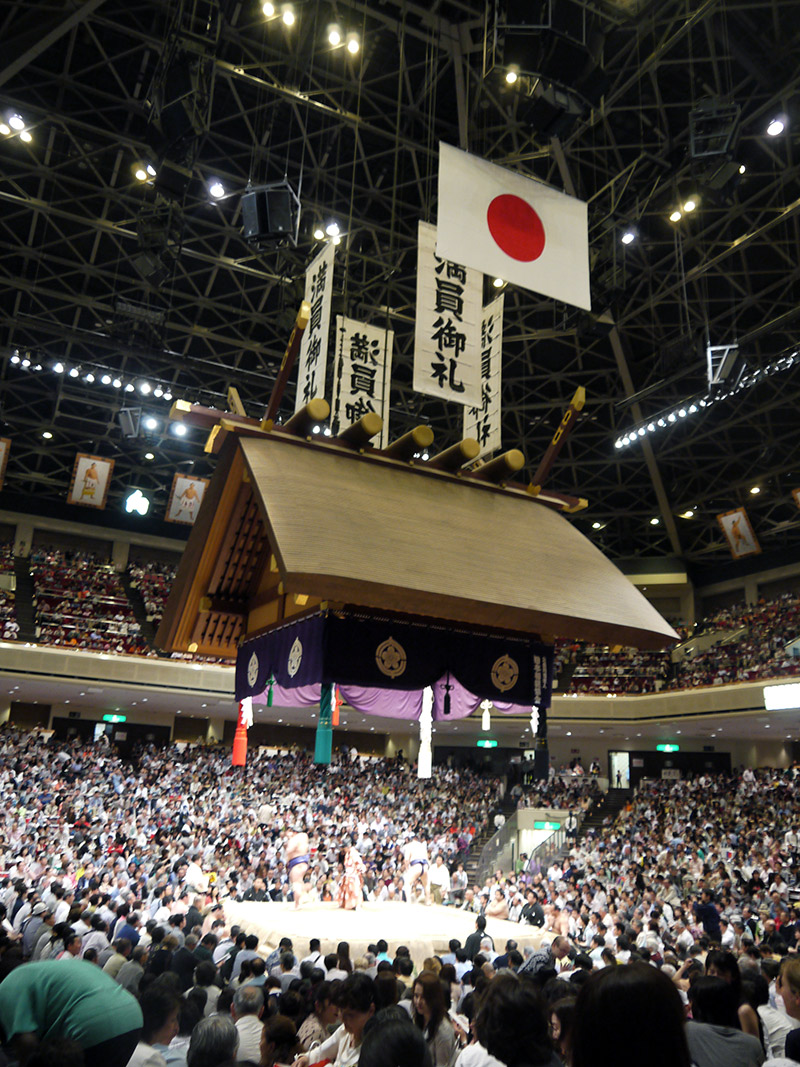
If you're afraid the decorative hanging rooftop might obstruct your view of the matches from the upper deck, don't fret. You'll see every hip slap and belly bounce. I was a bit surprised at how electric the atmosphere was.

Sumo is a fast sport. There's a lot of build-up, waiting, and anticipation. But once the wrestlers go at each other, the crowd goes crazy and you feel the energy in you chest. One wrestler will go down and it will all be over quicker than it began, but what a rush.

Another part of the fun is seeing the different kinds of wrestlers. Many wrestlers nowadays come from outside Japan, like this guy on the right. I like to imagine him as being an ALT (Assistant Language Teacher) who got tired of being pushed around by the bureaucracy of the Japanese school system, and this was his way of "pushing back". Sounds like a good premise for a screenplay, no? (©Mami Enterprises, 2015)
Seriously though, many sumo wrestlers who have gone on to become Yokozuna 横綱 (the highest rank in sumo) have come from Mongolia, Bulgaria, and Georgia (the country Georgia, not the U.S. state).

Makuuchi 幕内, a.k.a. Makunouchi 幕の内, is the top division of the six divisions of professional sumo wrestling. At around 3:30pm, they all gather in the ring to say hi to everyone. Hi sumo wrestlers!
The mawashi they're wearing are a special kind called keshō-mawashi 化粧回し. This is a ceremonial mawashi that the wrestlers wear when entering the ring. Nowadays, they have various ornamental embroideries that represent them. Sometimes the embroideries, instead of representing the wrestler will represent a brand. These ceremonial aprons can sometimes be advertisements. A popular sumo wrestler from Bulgaria wears an advertisement for Bulgaria Yogurt, a popular yogurt brand by Meiji.

A nice shot of the Makuuchi wrestlers' butts for our respected illustrator Aya, a.k.a. the butt lover. She loves butts as much as I love bacon. All hail the butts and hineys!

Even sumo matches have in-game advertising. These banner ads (called kensho) come on the stage before each battle. The term kensho doesn't refer to the banner, but the sponsorship. Each company pays ¥60,000 for each banner. Half that money goes to the Sumo Association and the other half goes to the sponsored wrestler IF the wrestler wins that particular round. It's an extra reward for winning matches. If they don't win, no kensho money for them. For more info on kensho, click here.

An old sumo tradition is throw your zabuton cushion toward the ring if something makes you upset. It's like boo-ing with pillows! I don't remember what exactly, but something made the audience upset. Suddenly, zabuton were flying everywhere. It all happened so fast that I couldn't get a great picture, but here you can clearly see a zabuton soaring toward the ring. Or maybe it's a UFO. Either way, the blurry lady in the bottom right is happy about it.

Not everyone was happy about the flying zabuton however. The man in the glasses is certainly perturbed. Since throwing zabuton is apparently dangerous, an announcement was made requesting that we not do it. But since it's a tradition, people will do it no matter what. Damn announcements can't hold us down!

This match was the grand finale of the day! Yokozuna Kakuryu and Hakuho fought against each other. Since Yokozuna is the highest rank in sumo, they wear shimenawa on their mawashi. This was the highlight of the event. The best of the best facing off. The excitement in the stadium was at its peak.
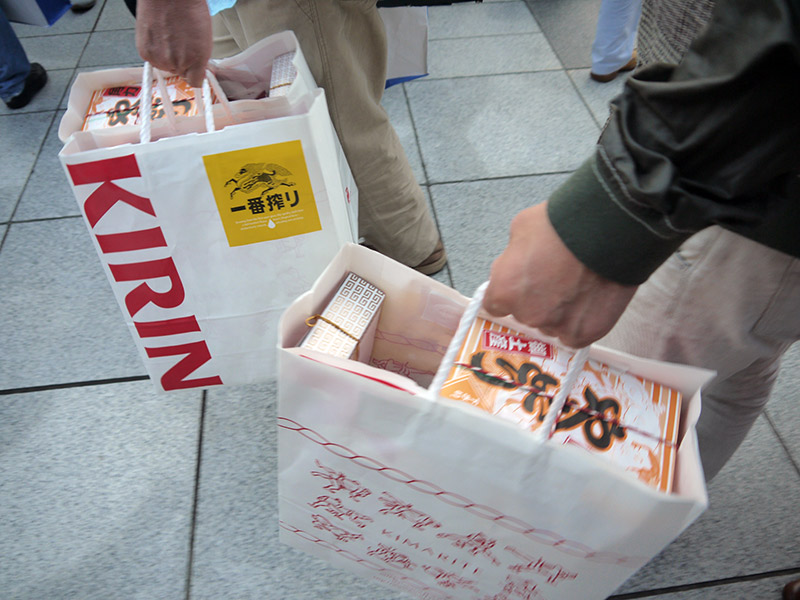
After a full day of wrestling madness, it's time to head home. If you ordered food and a souvenir package, you probably won't finish all of it in the stadium, so you will likely walk away with a bunch of goodies. いいおみやげ!

One of the things in the souvenir bag was sumo wrestler chocolate. They're pretty cute, eh? If you want, you can relive the excitement you just saw when you get home. Set the chocolate wrestlers out on the kitchen table and make them fight. Eat the loser. Bon Apetit!
Mami’s Review
My dad likes watching sumo on TV, but I wasn’t a big fan and always wanted to change it to an anime show. So, when I was invited to a sumo wrestling show, I wasn’t sure if I could enjoy it, but it was very cool to see the actual match in real life. If you come to Japan and get a chance to watch sumo wrestling, I DO recommend it.
Ryogoku Kokugikan
Additional Information
1-3-28 Yokoami
Sumida, Tokyo Prefecture 130-0015
Japan
+81 3-3622-0366
